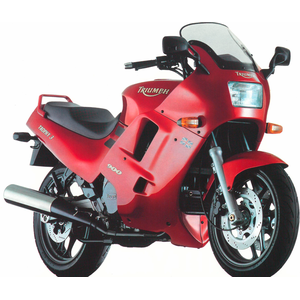Triumph Trophy 900 (1991–2001): A Thrumming Legacy of British Touring
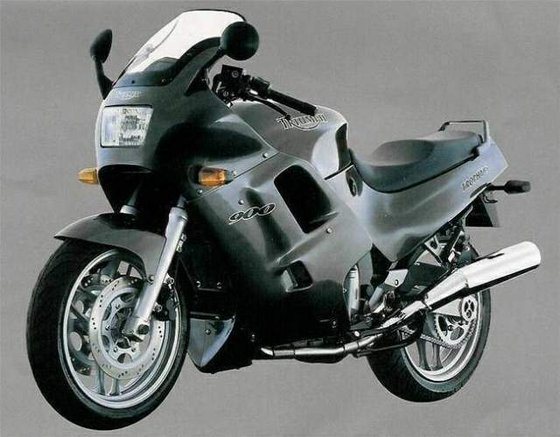
Introduction
The Triumph Trophy 900 isn’t just a motorcycle—it’s a declaration. Born in 1991 during Triumph’s modern resurgence, this inline-three touring machine carved a niche with its blend of characterful engineering and long-distance practicality. Over its decade-long production run, the Trophy 900 became synonymous with a distinct auditory signature—a deep, throaty thrummm—and a riding experience that balanced sporty vigor with touring comfort. Let’s dissect what made this British stalwart a cult favorite among riders who valued soul over sterility.
Engine Performance: The Heart of the Beast
At the core of the Trophy 900 lies its 885cc liquid-cooled inline-three engine, a configuration that remains rare even today. With 98 HP at 9,000 RPM and 83 Nm (61.2 ft.lbs) of torque peaking at 6,500 RPM, this powerplant is a masterclass in flexibility.
Key Highlights:
- Triple Charm: The 120° crank and twin balancer shafts deliver smoothness without sanitizing the experience. The engine thrums at idle, growls under acceleration, and sings a metallic wail at high revs—a soundtrack likened to a “British Aston Martin on two wheels.”
- Midrange Muscle: Torque arrives early and sticks around. Sixth-gear roll-ons from 50 mph (80 km/h) feel effortless, with minimal need to downshift. Test riders often compared its low-end grunt to larger-displacement bikes, calling it “a two-liter engine in a 900cc package.”
- Carbureted Character: Mikuni 36mm carburetors (pre-fuel injection) provide crisp throttle response, though they demand occasional tuning in colder climates.
Real-World Ride: On a twisty backroad, the Trophy’s engine shines. The surge from 4,000 RPM to the 9,500 RPM redline is linear, rewarding riders who exploit the six-speed gearbox. Yet, it’s happiest devouring highways, where the triple’s hum becomes a meditative companion.
Chassis and Handling: A Study in Contradictions
The Trophy 900’s steel trellis frame and 27° rake prioritize stability over flickability. With a wheelbase of 1,490 mm (58.7 in) and a dry weight of 220 kg (485 lbs), it’s no featherweight.
Riding Dynamics:
- Straight-Line Confidence: The long wheelbase and weight distribution inspire confidence at high speeds. At 130 mph (209 km/h), the Trophy feels planted, though the windscreen buffeting becomes noticeable.
- Cornering Compromises: Push hard into bends, and the Trophy reveals its touring DNA. The front 120/70-17 and rear 160/60-18 Dunlop Sports Radials (notorious for their era-specific mediocrity) lack modern grip, especially in wet conditions. Later models swapped to 17-inch rear wheels for sharper turn-in.
- Suspension Setup: The 43mm telescopic forks and tri-link rear suspension (with adjustable preload) absorb bumps competently but feel soft when loaded with luggage.
Test Ride Takeaway: This isn’t a sportbike masquerading as a tourer. It’s happiest on sweeping roads, where its stability and torque let you surf corners rather than attack them.
Touring Comfort: Miles Melt Away
Triumph designed the Trophy 900 to coddle riders on cross-continent trips.
Ergonomics:
- Seat and Posture: The 780 mm (30.7 in) seat is plush, with ample room for rider and pillion. The semi-sporty crouch (compared to the upright FJ1200) reduces fatigue on long hauls.
- Fairing and Wind Protection: The full fairing deflects wind reasonably well, though taller riders might crave an aftermarket taller screen. Integrated lockable panniers (72L total) are a godsend for touring.
- Fuel Efficiency: Averaging 6.8 L/100 km (34.8 US mpg), the 25L (6.6-gallon) tank delivers a 350–400 km (217–248 mi) range—enough to outlast most bladders.
Weak Spots: Engine heat wafts onto legs in traffic, and the mirrors vibrate at highway speeds. Still, these are quibbles in an otherwise stellar touring package.
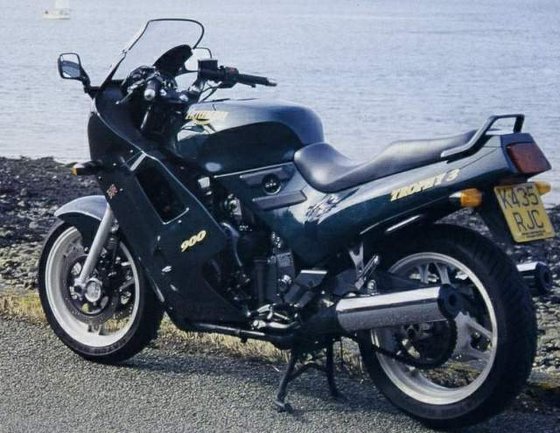
Competition: How the Trophy Stacked Up
The 1990s touring segment was fiercely competitive. Here’s how the Trophy 900 fared against rivals:
1. Honda VFR750 (1990–1997)
- Strengths: Honda’s V4 engine was silkier, with a 12,000 RPM redline and legendary reliability. The single-sided swingarm and linked brakes exuded sophistication.
- Weaknesses: Less torque (69 Nm) meant frequent gear changes. The 19L tank limited range to ~200 miles.
- Verdict: The VFR was the sharper tool for twisties, but the Trophy’s torque and comfort won on endurance rides.
2. Yamaha FJ1200 (1984–1996)
- Strengths: A 1,188cc inline-four brute with 130 HP and sublime wind protection.
- Weaknesses: Heavier (260 kg wet) and less engaging. Felt like piloting a locomotive.
- Verdict: The FJ excelled in raw power, but the Trophy’s agility and character made it more fun.
3. BMW K75 (1985–1996)
- Strengths: BMW’s flat-three engine and shaft drive were bulletproof. Lower seat height (760 mm) suited shorter riders.
- Weaknesses: Anemic 75 HP and bland styling.
- Verdict: The K75 was pragmatic, but the Trophy offered visceral thrills.
Maintenance: Keeping the Legend Alive
Owners swear by the Trophy 900’s robustness, but proactive care ensures longevity. Here’s what to prioritize:
1. Valve Adjustments
- Interval: Every 12,000 km (7,500 mi).
- Specs: Intake valves: 0.10 mm (0.004 in), exhaust: 0.15 mm (0.006 in). Use feeler gauges and patience.
2. Oil Changes
- Interval: Every 6,000 km (3,700 mi) with 10W-40 semi-synthetic. Capacity: 3.8L (4.0 US qt) with filter.
3. Carburetor Tuning
- Tip: Clean jets annually, especially if stored with ethanol fuel. Sync carbs using vacuum gauges for smoother idle.
4. Chain and Sprockets
- Setup: 17T front/46T rear sprockets with 112-link chain. Lubricate every 500 km (310 mi).
5. Brake Upgrades
- Weak Point: The stock Nissin calipers lack bite. Consider sintered pads or retrofitting braided lines from MOTOPARTS.store.
6. Cooling System
- Fluid: Replace coolant every 2 years (2.8L of ethylene glycol mix). Check for leaks at the water pump.
Pro Tip: The stock Dunlops underwhelm. Swap to modern rubber like Michelin Road 6 for transformative grip.
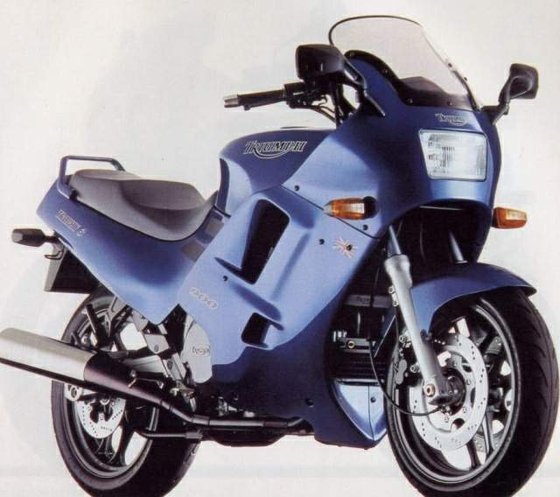
Conclusion: A Timeless Triple for the Soulful Rider
The Triumph Trophy 900 isn’t about spec-sheet dominance. It’s about the way the triple’s vibrations sync with your heartbeat, the way miles dissolve beneath its tank, and the way it turns petrolheads into poets. While later tourers eclipsed it in tech, none replicated its charisma.
For owners, MOTOPARTS.store offers everything from OEM-spec spark plugs (NGK DPR8EA-9) to performance exhausts—because legends deserve to stay on the road.
Thrum on.
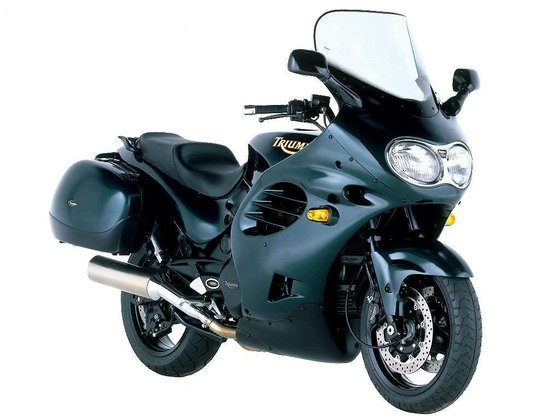


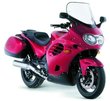

Specifications sheet
| Engine | |
|---|---|
| Stroke: | Four-stroke |
| Ignition: | TCI (Transistor Controlled Ignition) |
| Max power: | 71 kW | 95.0 hp |
| Max torque: | 83 Nm |
| Fuel system: | 3 x 36 mm Mikuni carburetors |
| Lubrication: | Wet sump |
| Max power @: | 9000 rpm |
| Displacement: | 885 ccm |
| Max torque @: | 6500 rpm |
| Configuration: | Inline |
| Cooling system: | Liquid |
| Compression ratio: | 10.6:1 |
| Number of cylinders: | 3 |
| Dimensions | |
|---|---|
| Wheelbase: | 1490 mm (58.7 in) |
| Dry weight: | 217 |
| Wet weight: | 250 |
| Seat height: | 780 mm (30.7 in) |
| Fuel tank capacity: | 25 L (6.6 US gal) |
| Drivetrain | |
|---|---|
| Final drive: | chain |
| Chain length: | 118 |
| Transmission: | 6-speed |
| Rear sprocket: | 47 |
| Front sprocket: | 15 |
| Maintenance | |
|---|---|
| Rear tire: | 160/60 v-18 |
| Engine oil: | 10W40 |
| Front tire: | 120/70 v-17 |
| Brake fluid: | DOT 4 |
| Spark plugs: | NGK DPR8EA-9 or NGK DPR8EIX-9 |
| Spark plug gap: | 0.9 |
| Coolant capacity: | 2.8 |
| Forks oil capacity: | 1.18 |
| Engine oil capacity: | 3.8 |
| Valve clearance (intake, cold): | 0.10 mm |
| Valve clearance (exhaust, cold): | 0.15 mm |
| Recommended tire pressure (rear): | 2.9 bar (42 psi) |
| Recommended tire pressure (front): | 2.5 bar (36 psi) |
| Chassis and Suspension | |
|---|---|
| Rake: | 27° |
| Frame: | Steel trellis |
| Trail: | 104 mm (4.1 in) |
| Rear tire: | 160/60 v-18 |
| Front tire: | 120/70 v-17 |
| Rear brakes: | Single 255 mm disc, 2-piston Nissin caliper |
| Front brakes: | 2 x 296 mm discs, 4-piston Nissin calipers |
| Rear suspension: | Tri-link rising rate with adjustable preload |
| Front suspension: | 43 mm telescopic forks |



